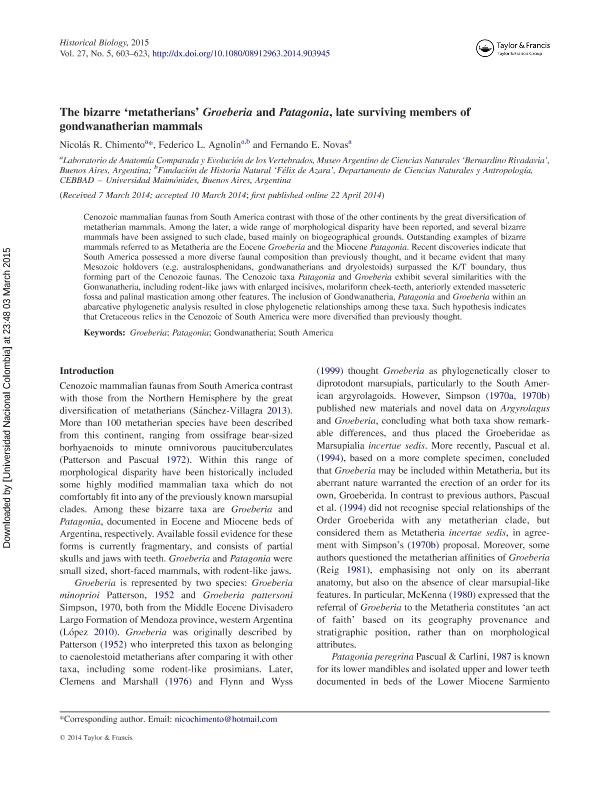Mostrar el registro sencillo del ítem
dc.contributor.author
Chimento, Nicolás Roberto

dc.contributor.author
Agnolin, Federico

dc.contributor.author
Novas, Fernando Emilio

dc.date.available
2019-10-02T20:50:14Z
dc.date.issued
2015-07
dc.identifier.citation
Chimento, Nicolás Roberto; Agnolin, Federico; Novas, Fernando Emilio; The bizarre ‘metatherians’ Groeberia and Patagonia, late surviving members of gondwanatherian mammals; Taylor & Francis; Historical Biology; 27; 5; 7-2015; 603-623
dc.identifier.issn
0891-2963
dc.identifier.uri
http://hdl.handle.net/11336/85076
dc.description.abstract
Cenozoic mammalian faunas from South America contrast with those of the other continents by the great diversification of metatherian mammals. Among the later, a wide range of morphological disparity have been reported, and several bizarre mammals have been assigned to such clade, based mainly on biogeographical grounds. Outstanding examples of bizarre mammals referred to as Metatheria are the Eocene Groeberia and the Miocene Patagonia. Recent discoveries indicate that South America possessed a more diverse faunal composition than previously thought, and it became evident that many Mesozoic holdovers (e.g. australosphenidans, gondwanatherians and dryolestoids) surpassed the K/T boundary, thus forming part of the Cenozoic faunas. The Cenozoic taxa Patagonia and Groeberia exhibit several similarities with the Gonwanatheria, including rodent-like jaws with enlarged incisives, molariform cheek-teeth, anteriorly extended masseteric fossa and palinal mastication among other features. The inclusion of Gondwanatheria, Patagonia and Groeberia within an abarcative phylogenetic analysis resulted in close phylogenetic relationships among these taxa. Such hypothesis indicates that Cretaceous relics in the Cenozoic of South America were more diversified than previously thought.
dc.format
application/pdf
dc.language.iso
eng
dc.publisher
Taylor & Francis

dc.rights
info:eu-repo/semantics/openAccess
dc.rights.uri
https://creativecommons.org/licenses/by-nc-sa/2.5/ar/
dc.subject
GONDWANATHERIA
dc.subject
GROEBERIA
dc.subject
PATAGONIA
dc.subject
SOUTH AMERICA
dc.subject.classification
Paleontología

dc.subject.classification
Ciencias de la Tierra y relacionadas con el Medio Ambiente

dc.subject.classification
CIENCIAS NATURALES Y EXACTAS

dc.title
The bizarre ‘metatherians’ Groeberia and Patagonia, late surviving members of gondwanatherian mammals
dc.type
info:eu-repo/semantics/article
dc.type
info:ar-repo/semantics/artículo
dc.type
info:eu-repo/semantics/publishedVersion
dc.date.updated
2019-10-02T14:28:45Z
dc.journal.volume
27
dc.journal.number
5
dc.journal.pagination
603-623
dc.journal.pais
Reino Unido

dc.description.fil
Fil: Chimento, Nicolás Roberto. Consejo Nacional de Investigaciones Científicas y Técnicas. Oficina de Coordinación Administrativa Parque Centenario. Museo Argentino de Ciencias Naturales “Bernardino Rivadavia”; Argentina
dc.description.fil
Fil: Agnolin, Federico. Universidad Maimónides; Argentina. Consejo Nacional de Investigaciones Científicas y Técnicas. Oficina de Coordinación Administrativa Parque Centenario. Museo Argentino de Ciencias Naturales “Bernardino Rivadavia”; Argentina
dc.description.fil
Fil: Novas, Fernando Emilio. Consejo Nacional de Investigaciones Científicas y Técnicas. Oficina de Coordinación Administrativa Parque Centenario. Museo Argentino de Ciencias Naturales “Bernardino Rivadavia”; Argentina
dc.journal.title
Historical Biology
dc.relation.alternativeid
info:eu-repo/semantics/altIdentifier/doi/http://dx.doi.org/10.1080/08912963.2014.903945
dc.relation.alternativeid
info:eu-repo/semantics/altIdentifier/url/https://www.tandfonline.com/doi/abs/10.1080/08912963.2014.903945
Archivos asociados
